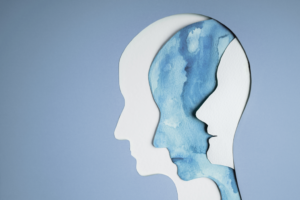Euthymia in Bipolar Disorder: the Calm After the Storm

To a greater or lesser extent, we imagine that bipolar disorder is characterized by extreme mood swings, which can range from depression to mania. However, something less known is the fact that these two extremes don’t constantly alternate with each other. In fact, there exists between them a quiet period of apparent normality. This calm between the storm is what’s known as euthymia in bipolar disorder.
Contrary to popular belief, and unlike in other conditions such as borderline personality disorder, changes in the mood of bipolar patients aren’t sudden or momentary. In other words, the person doesn’t experience variations in the course of a day. As a matter of fact, both manic and depressive episodes can often last for weeks or months. In addition, there’s a period between episodes when the person is free of symptoms.
However, what exactly is euthymia and how long do these calm episodes last? Are the patients really in a state of normality similar to the one that preceded the onset of the disorder? Is there anything that can be done to extend the period of euthymia? We address these issues below.

Euthymia in bipolar disorder
Bipolar disorder is characterized by the presence of different types of episodes that drastically affect mood. During manic episodes the patient experiences hyperthymia. This manifests as an abnormally high mood. It’s accompanied by euphoria, over-activity, verbiage, and uncontrolled risk-taking.
On the other hand, during depressive episodes, a hypothymic mood appears. This is characterized by loss of pleasure and interest, feelings of guilt, sleep and appetite disturbances, and even thoughts of suicide. Furthermore, it’s possible that mixed episodes may occur, combining manifestations of the two.
Therefore, euthymia in bipolar disorder refers to the periods between hypothymia and hyperthymia. It’s a moment when the patient is completely free of symptoms and in a state of calm and normality.
Euthymia comes from the Greek word that means ‘good spirits’. In this phase, the person is in a state of well-being and relaxation, having control over their own feelings. They’re in possession of their mental faculties and social skills and they function normally.
Does euthymia imply the absence of symptoms?
In the first instance, euthymia is considered a phase of remission. During this phase, the mood stabilizes and the patient normalizes. In this way, it could be said that they recover their emotional level prior to their bipolar episodes, maintaining normal daily functioning. However, certain studies have found evidence that casts doubt on this idea.
As a matter of fact, the research suggests that, even in euthymia, bipolar patients may present some type of slowing down or cognitive impairment. Indeed, concentration, learning, and memory problems occur even in these interim periods.
However, it’s not yet been clearly determined whether these cognitive changes are the result of the disease, the patient’s own predisposition, or some side effect of their medication.

How to prolong this state?
One of the main objectives in working with these patients is to maintain the euthymia phase in bipolar disorder. However, it’s important to emphasize that it’s not possible to achieve absolute stability. Indeed, euthymia is a period of remission, but not of healing or recovery. In fact, these patients will always possess the disposition to experience different emotional states with greater intensity.
However, the importance of good treatment is highly relevant here. As a matter of fact, appropriate pharmacological treatment, together with psychoeducation can help the person to both maintain and prolong the state of euthymia.
Understanding the disorder and having helpful personal tools to cope with it can make a significant difference. Therefore, it’s vitally important for patients to adhere to any prescribed treatment.
All cited sources were thoroughly reviewed by our team to ensure their quality, reliability, currency, and validity. The bibliography of this article was considered reliable and of academic or scientific accuracy.
- Benítez, M. J., Fernández, S., Robles, I., Másmela, S. M., Jaramillo, C. L., Valencia, J. G., … & Duque, J. O. (2003). Características neuropsicológicas del trastorno bipolar I. Revista Colombiana de Psiquiatría, 32(4), 357-372.
- García, J. A. B. (2010). Alteraciones de memoria en la fase eutímica del trastorno bipolar de inicio en la adolescencia: estudio de dos casos. International Journal of Psychology and Psychological Therapy, 10(3), 489-498.
This text is provided for informational purposes only and does not replace consultation with a professional. If in doubt, consult your specialist.








